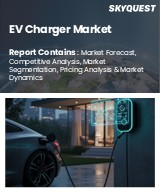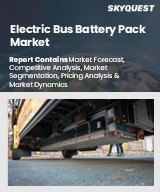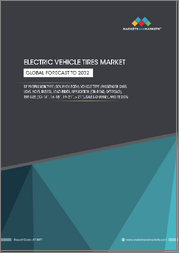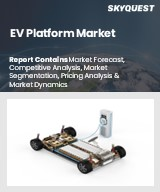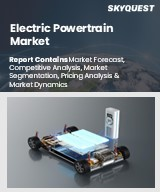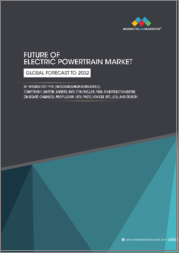
|
시장보고서
상품코드
1584542
세계의 E-Powertrain 시장 예측(-2032년) : 차종별, 컴포넌트별Future of E-Powertrain Market by integration type (Integrated & Non-integrated), Component (Motor, Battery, BMS, Controller, PDM, Inverter/Converter, On-Board Charger), Propulsion (BEV, PHEV), Vehicle Type (PC & LCV) and Region - Global Forecast to 2032 |
||||||
E-Powertrain 시장 규모는 2024년 1,818만 1,000대에서 2032년에는 5,128만 8,000대로 성장하며, 예측 기간 중 CAGR은 13.8%로 예측됩니다.
더 많은 소비자와 기업이 전기자동차의 이점을 인식함에 따라 시장이 성장할 것으로 예상됩니다. 모든 주요 OEM 업체들이 무공해 자동차에 대한 야심찬 목표를 세우고 있는 가운데, 배터리 전기자동차(BEV)가 큰 시장 점유율을 차지할 것으로 예상되며, IEA에 따르면 현재 전기자동차의 총 판매량은 약 4,000만 대에 달할 전망입니다. 중국, 유럽, 미국에 판매량이 집중되어 세계 시장의 95%를 차지하고 있으며, 2023년에는 중국에서만 전 세계 전기자동차 판매량의 60%, 유럽이 25%, 미국이 10%를 차지할 것으로 전망하고 있습니다. 전기자동차 시장이 성숙해짐에 따라 가격 경쟁의 심화, 규제 변화, 배터리 재활용에 대한 고려가 전기자동차 시장의 환경을 더욱 변화시킬 것으로 예상됩니다.
| 조사 범위 | |
|---|---|
| 조사 대상년 | 2019-2030년 |
| 기준년 | 2024년 |
| 예측 기간 | 2024-2032년 |
| 대상 대수 | 대수(1,000대) |
| 부문 | 차종별, 컴포넌트별 |
| 대상 지역 | 북미, 유럽, 아시아태평양 |
중국은 정부의 강력한 지원, 현지 제조 우위, 탄탄한 인프라에 힘입어 세계 전기 승용차 시장을 선도하고 있습니다. 중국 전기자동차 판매량의 약 70%는 경제형 또는 중급형 모델이며, 프리미엄 모델은 30%를 차지합니다. 독일, 프랑스, 노르웨이, 스웨덴, 영국은 2035년까지 무공해화를 목표로 하는 규제로 인해 전기자동차에 대한 수요가 증가하고 있습니다. 전 세계에서 볼 때, 사용되는 전기자동차의 70% 이상이 2-in-1 및 3-in-1 설계와 같이 완전히 통합된 시스템과 통합된 파워트레인을 탑재하고 있습니다. 아시아태평양은 항상 SUV가 우세한 지역으로 전기자동차 판매의 60%를 차지합니다. 이러한 수요는 배터리용량, 모터 유형 및 파워 일렉트로닉스의 기술 혁신을 주도하고 있습니다.
제조업체들은 전기자동차의 효율, 성능, 충전 속도를 향상시키는 데 도움이 되는 차세대 영구 자석 동기 모터(PMSM)와 800V 고전압 아키텍처에 초점을 맞추고 있으며, 특히 BYD Seal 및 Porsche Macan EV와 같은 모델이 자율주행을 위해 6상 모터를 채택함에 따라 이러한 추세에 힘을 실어줄 것이다, 이러한 추세에 힘을 실어줄 것입니다. 이러한 기술은 이러한 잠재적 수요를 포착하고 향후 시장 확장을 촉진하는 데 필수적입니다.
세계의 E-Powertrain 시장에 대해 조사했으며, 차종별, 컴포넌트별 동향 및 시장에 참여하는 기업의 개요 등을 정리하여 전해드립니다.
목차
제1장 서론
제2장 개요
제3장 E-Powertrain 시장(차종별)
- 서론
- 승용차
- 소형 상용차
제4장 승용차용 E-Powertrain 시장(컴포넌트별)
- 서론
- 모터
- 배터리
- 배터리 관리 시스템
- 컨트롤 유닛
- 인버터
- 전력 분배 모듈
- 온보드 충전기
제5장 LCV BEV용 파워트레인 시장(컴포넌트별)
- 서론
- 모터
- 배터리
- 배터리 관리 시스템
- 컨트롤 유닛
- 인버터
- 전력 분배 모듈
- 온보드 충전기
제6장 E-Powertrain의 규제 프레임워크
- 지속가능성과 넷 카본 뉴트럴 목표
- 유럽
- 아시아태평양
- 북미
- OEM 전동화 목표와 투자
- 주요 기업별 전기자동차 커미트먼트
- 배출 가스 및 연비 기준
제7장 에너지 포트폴리오 믹스
제8장 모듈화와 플랫폼 전략
- VOLKSWAGEN
- BMW
- STELLANTIS
- FORD
- GENERAL MOTORS
- RENAULT NISSAN MITSUBISHI
- TOYOTA
- HYUNDAI
- HONDA MOTOR CO., LTD
제9장 기술 분석
- 서론
- 통합 E-Powertrain 시스템
- 통합 드라이브 시스템의 가격 분석
- 전기 모터
- 파워 일렉트로닉스
- 배터리
- 모터의 열관리
제10장 기업 개요
- ROBERT BOSCH GMBH
- MAGNA INTERNATIONAL INC.
- BORGWARNER INC.
- ZF FRIEDRICHSHAFEN AG
- DENSO CORPORATION
- VALEO
- MITSUBISHI ELECTRIC CORPORATION
- VITESCO TECHNOLOGIES GMBH
- DANA LIMITED
- HITACHI ASTEMO, LTD.
- CATL
- BYD COMPANY LTD.
- LG ENERGY SOLUTION
- PANASONIC ENERGY CO., LTD.
- SAMSUNG SDI
제11장 최종 결론과 권장사항
제12장 부록
KSA 24.11.14The electric powertrain market is projected to grow from 18,181 thousand units in 2024 to 51,288 thousand units by 2032, at a CAGR of 13.8% during the forecast period. The market is expected to grow as more consumers and businesses realize the benefits of electric vehicles. With ambitious goals set by all major OEMs for zero-emission vehicles to meet net-zero emissions targets, battery electric vehicles (BEVs) are projected to capture a significant market share. According to IEA, the total number of electric cars on the road is now ~40 million, with sales concentrated mainly in China, Europe, and the United States, which account for 95% of the global market. In 2023, China alone accounted for 60% of global EV sales, while Europe and the US contributed 25% and 10%, respectively. The growing adoption of EVs is due to government incentives, technological advancements, and the need for sustainable transport, fuelling demand for efficient e-powertrain systems. As the EV market matures, increased price competition, regulatory changes, and battery recycling considerations will further shape the e-powertrain landscape.
| Scope of the Report | |
|---|---|
| Years Considered for the Study | 2019-2030 |
| Base Year | 2024 |
| Forecast Period | 2024-2032 |
| Units Considered | Volume (Thousand Units) |
| Segments | Integration type, Component, Propulsion, Vehicle Type (PC & LCV) and Region |
| Regions covered | North America, Europe, and Asia-Pacific |
"Passenger cars segment is estimated to hold the largest market share during the forecast period."
China leads the global electric passenger car market, driven by strong government support, local manufacturing dominance, and a robust infrastructure. Nearly 70% of EV sales in China involve economy or mid-range models, while the premium ones account for 30%. Electric cars are highly in demand in Germany, France, Norway, Sweden, and the UK through regulations that now aim to have zero emissions by 2035 although targets are likely to be reviewed by 2025. In an expanded global perspective, more than 70% of electric vehicles in use have powertrains integrated with fully integrated systems such as 2-in-1 and 3-in-1 designs. APAC is a place where SUVs always dominate, accounting for 60% of the sales of EVs. This demand drives innovations in battery capacity, types of motor, and power electronics.
Manufacturers are focusing on next-generation Permanent Magnet Synchronous Motors (PMSMs) and 800V high-voltage architectures that will help to better the efficiency, performance, and charging speeds for electric vehicles. Models like the BYD Seal and the Porsche Macan EV should help drive these trends, particularly with the higher adoption of 6-phase motors, especially for autonomous driving. Such technologies will be critical for capturing this nascent demand and furthering the expansion of the market in the coming future.
"E-motors is estimated to be the fastest growing market by 2032."
E-motors are projected to grow fastest in the electric powertrain market by 2032, driven by the need for higher efficiency and performance. Most of the electric passenger cars which exist today use 60-100 kW motors or PMSMs. For premium models like BMW and Tesla, they are using 100-200 kW motors mainly for high performance and good range.
Mostly EVs today mainly use Permanent Magnet Synchronous Motors (PMSMs) for their efficiency and cost-effectiveness, particularly in mid-range cars. In the future, we will see a shift towards advanced motor types, such as Axial Flux Motors and Permanent Magnet-Assisted Synchronous Reluctance Motors, which offer higher torque, power density, and improved efficiency. Such technologies are in high demand, owing to compact design and minimal usage of rare earth metals.
The cost of e-motors is expected to further decrease as by 2025 with the advancement of high-voltage architectures and integrated motor designs, hereby advancing it toward wider accessibility of EVs. Future e-motors will come in the form of dual-motor configurations for AWD and high performance, designing with a strong emphasis on modularity, energy efficiency, and sustainability.
"Europe is anticipated to be one of the fastest markets over the forecast period."
As the adoption of EVs has grown significantly, automakers are providing extended ranges and an increased number of models that offer more choices and innovative features, which is why many buyers are now considering electric and hybrid vehicles as their next purchase. Several leading automobile manufacturers have been investing significantly in electric vehicles by the producers of Europe, and subsequently, there is a greater variety of battery electric vehicles arriving in Europe.
In Europe, the EV market is dominated by compact, mid-size, and premium models with battery capacities ranging from 40 kWh to over 100 kWh. Compact and mid-size EVs are available with 40-60 kWh battery capacities and more premium models with 70-100 kWh+ battery capacities. The long-range and performance variants are preferred with higher capacity batteries. The major key OEM for the battery category includes Volkswagen, Tesla, Renault, BMW, and Mercedes-Benz, and more in capacities.
European auto manufacturers are investing in 800V powertrain architectures that support fast charging and efficiency, electric motors more efficient than those available today, and integrated thermal management. Particularly integrated ePowertrains have also become mainstream today because they also can reduce costs and allow for higher scalability. Solid state batteries will yield even bigger leaps forward soon. As automakers ramp up production and diversify their BEV offerings, this momentum drives significant growth in the powertrain market. Increased demand for electric vehicles and advancements in vehicle technology will continue to fuel the development and expansion of powertrain systems, which are essential for EVs' performance, efficiency, and sustainability.
- By Company Type: Tier 1 - 70%, Tier 2 - 30%.
- By Designation: C Level - 40%, D Level - 35%, and Others - 25%
- By Region: North America - 5%, Europe - 20%, Asia Pacific - 60%, and ROW- 5%
Research Coverage:
The electric powertrain market is segmented by vehicle type (Passenger Cars and Light Commercial Vehicles) and region (Asia Pacific, Europe, and North America). The market study includes technology analysis (E-Motors, Batteries, Thermal/Battery Management, Power Electronics), Supplier Analysis, and Regulatory Framework.
Reasons to buy this report:
The report will provide market leaders and new entrants with information on the closest approximations of the sales numbers for the E-powertrain market and its subsegments. It will also help stakeholders understand the competitive landscape and gain more insights to better position their businesses and plan suitable go-to-market strategies.
The report provides insights on the following pointers:
Technology Analysis: Insights on current and upcoming technologies, future investments, and critical OEMs and supplier strategies. Covered major electric powertrain components, technological trends such as the Integrated Drive system, and market players providing these.
- Market Landscape by vehicle type (Passenger Cars and Light Commercial Vehicles), by propulsion type (BEV and PHEV), By integration type (Integrated vs. Non-integrated)
- Supplier Analysis: The report analyzes market players, growth strategies, and product offerings of leading players. It also helps stakeholders understand the strategy of the electric powertrain key suppliers and provides information on their recent developments and investments in the market. OEM-wise decarbonization targets are also covered.
- Pricing Analysis: The report consists of pricing analysis for integrated vs. non-integrated drive systems.
TABLE OF CONTENTS
1 INTRODUCTION
- 1.1 MARKET DEFINITION
- 1.2 MARKET SCOPE
- 1.3 RESEARCH METHODOLOGY
- 1.3.1 SECONDARY DATA
- 1.3.1.1 List of secondary sources for estimating vehicle production and sales
- 1.3.1.2 Key secondary research referred for market sizing
- 1.3.1.3 Key data from secondary sources
- 1.3.2 PRIMARY DATA
- 1.3.2.1 List of primary participants
- 1.3.1 SECONDARY DATA
- 1.4 MARKET SIZE ESTIMATION
- 1.4.1 ELECTRIC POWERTRAIN MARKET: BOTTOM-UP APPROACH
- 1.4.2 ELECTRIC POWERTRAIN MARKET: TOP-DOWN APPROACH
- 1.5 MARKET BREAKDOWN AND DATA TRIANGULATION
- 1.6 RESEARCH ASSUMPTIONS
- 1.7 RISK AND IMPACT ANALYSIS
- 1.8 RESEARCH LIMITATIONS
2 EXECUTIVE SUMMARY
- 2.1 ICE VS. BEV POWERTRAIN PORTFOLIO MIX
- 2.2 ICE VS. ELECTRIC PASSENGER CARS MARKET, BY PROPULSION
- 2.3 INTEGRATED VS. NON-INTEGRATED ELECTRIC POWERTRAINS
- 2.4 ELECTRIC POWERTRAIN MARKET, BY REGION
3 ELECTRIC POWERTRAIN MARKET, BY VEHICLE TYPE
- 3.1 INTRODUCTION
- 3.2 PASSENGER CARS
- 3.2.1 RISE IN ELECTRIFICATION TARGETS TO DRIVE MARKET
- 3.3 LIGHT COMMERCIAL VEHICLES
- 3.3.1 INCREASE IN EMISSION-FREE SUPPLY CHAIN INDUSTRY TO DRIVE MARKET
4 PASSENGER CAR ELECTRIC POWERTRAIN MARKET, BY COMPONENT
- 4.1 INTRODUCTION
- 4.2 MOTORS
- 4.2.1 RISING DEMAND FOR MOTORS IN BEVS TO DRIVE MARKET
- 4.3 BATTERIES
- 4.3.1 ONGOING DEVELOPMENTS IN LITHIUM-ION BATTERIES TO DRIVE DEMAND FOR BATTERIES
- 4.4 BATTERY MANAGEMENT SYSTEMS
- 4.4.1 GROWING PREFERENCE FOR HIGH-PERFORMANCE EVS TO DRIVE DEMAND
- 4.5 CONTROL UNITS
- 4.5.1 INCREASING USE OF MOTORS TO IMPROVE BEV PERFORMANCE TO DRIVE DEMAND
- 4.6 INVERTERS
- 4.6.1 INNOVATIONS IN INVERTERS TO DRIVE MARKET
- 4.7 POWER DISTRIBUTION MODULES
- 4.7.1 NEED FOR SAFETY OF DRIVERS AND PROPER FUNCTIONING OF ELECTRONIC COMPONENTS TO DRIVE MARKET
- 4.8 ON-BOARD CHARGERS
- 4.8.1 NEED FOR SAFE AND EFFECTIVE CHARGING OF BATTERIES TO DRIVE DEMAND
5 LCV BEV POWERTRAIN MARKET, BY COMPONENT
- 5.1 INTRODUCTION
- 5.2 MOTORS
- 5.2.1 INCREASE IN DEMAND FOR ENERGY-EFFICIENT MOTORS TO DRIVE MARKET
- 5.3 BATTERIES
- 5.3.1 RISE IN DEMAND FOR LONG-RANGE BATTERIES TO DRIVE MARKET
- 5.4 BATTERY MANAGEMENT SYSTEMS
- 5.4.1 SAFETY RISKS ASSOCIATED WITH BATTERIES TO DRIVE DEMAND
- 5.5 CONTROL UNITS
- 5.5.1 INNOVATIONS IN MOTOR ELECTRONICS TO DRIVE DEMAND
- 5.6 INVERTERS
- 5.6.1 RAPID TECHNOLOGICAL DEVELOPMENTS IN INVERTER TECHNOLOGIES TO DRIVE MARKET
- 5.7 POWER DISTRIBUTION MODULES
- 5.7.1 NEED FOR PROPER MAINTENANCE OF DIFFERENT CONTROL UNITS TO DRIVE DEMAND
- 5.8 ON-BOARD CHARGERS
- 5.8.1 DUAL ROLE OF ONBOARD CHARGERS TO DRIVE MARKET
6 ELECTRIC POWERTRAIN REGULATORY FRAMEWORK
- 6.1 SUSTAINABILITY AND NET-CARBON NEUTRALITY TARGETS
- 6.1.1 EUROPE
- 6.1.2 ASIA PACIFIC
- 6.1.3 NORTH AMERICA
- 6.2 OEM ELECTRIFICATION TARGETS AND INVESTMENTS
- 6.2.1 OEMS VS. ELECTRIFICATION TARGETS
- 6.2.2 OEM INVESTMENTS FOR ELECTRIFICATION
- 6.3 ELECTRIC FLEET COMMITMENTS BY LEADING COMPANIES
- 6.4 EMISSION & FUEL ECONOMY NORMS
- 6.4.1 OVERVIEW OF GLOBAL EMISSION STANDARDS
- 6.4.2 EMISSION NORMS IN CRITICAL COUNTRIES
- 6.4.2.1 China
- 6.4.2.1.1 Recent regulations
- 6.4.2.1.2 Upcoming regulations
- 6.4.2.1.2.1 China 7
- 6.4.2.1 China
- 6.4.3 JAPAN
- 6.4.3.1 Upcoming regulations in Japan
- 6.4.3.2 Next phase regulations
- 6.4.4 INDIA
- 6.4.4.1 Upcoming regulations
- 6.4.4.1.1 Recent vs. upcoming emission regulations
- 6.4.4.1 Upcoming regulations
- 6.4.5 EUROPE
- 6.4.5.1 Recent regulations
- 6.4.5.2 Upcoming regulations
- 6.4.5.3 Euro 7: Pollutant emission limits
- 6.4.5.4 Recent vs. upcoming emission regulations
- 6.4.5.5 Euro 6 Vs. Euro 7: NOX & PM emission reduction
- 6.4.6 US
- 6.4.6.1 Recent emission regulations
- 6.4.6.1.1 Upcoming regulations
- 6.4.6.1.2 Recent vs. upcoming regulations
- 6.4.6.1 Recent emission regulations
7 ENERGY PORTFOLIO MIX
- 7.1 PASSENGER CAR ENERGY PORTFOLIO MIX
- 7.1.1 PASSENGER CAR SALES, BY TYPE
- 7.1.2 PASSENGER CAR POWERTRAIN SHARE
- 7.1.3 PASSENGER CAR SALES, BY VEHICLE TYPE (2023 VS. 2030)
- 7.1.4 HATCHBACK
- 7.1.5 SEDANS
- 7.1.6 SUVS
- 7.1.7 MPVS
- 7.1.8 REGION-WISE EV SALE TRENDS
- 7.1.8.1 Asia Pacific
- 7.1.8.2 Passenger Car ICE Vs. EV Share
- 7.1.8.3 China
- 7.1.8.4 India
- 7.1.8.5 Japan
- 7.1.8.6 South Korea
- 7.1.9 EUROPE
- 7.1.9.1 Germany
- 7.1.9.2 France
- 7.1.9.3 Denmark
- 7.1.9.4 Netherlands
- 7.1.9.5 Norway
- 7.1.9.6 Sweden
- 7.1.9.7 UK
- 7.1.10 NORTH AMERICA
- 7.1.10.1 US
- 7.1.10.2 Canada
8 MODULARIZATION AND PLATFORM STRATEGIES
- 8.1 VOLKSWAGEN
- 8.1.1 VOLKSWAGEN PLATFORM STRATEGY
- 8.1.2 BMW
- 8.1.2.1 BMW platform strategy
- 8.1.3 STELLANTIS
- 8.1.3.1 Stellantis platform strategy
- 8.1.4 FORD
- 8.1.4.1 Ford platform strategy
- 8.1.5 GENERAL MOTORS
- 8.1.5.1 General Motors platform strategy
- 8.1.6 RENAULT NISSAN MITSUBISHI
- 8.1.6.1 Renault Nissan Mitsubishi platform strategy
- 8.1.7 TOYOTA
- 8.1.7.1 Toyota platform strategy
- 8.1.8 HYUNDAI
- 8.1.8.1 Hyundai platform strategy
- 8.1.9 HONDA MOTOR CO., LTD
- 8.1.9.1 Honda Motor Co., Ltd platform strategy
9 TECHNOLOGY ANALYSIS
- 9.1 INTRODUCTION
- 9.2 INTEGRATED ELECTRIC POWERTRAIN SYSTEM
- 9.2.1 4-IN-1
- 9.2.2 5-IN-1
- 9.2.3 6-IN-1
- 9.2.4 8-IN-1
- 9.3 PRICING ANALYSIS FOR INTEGRATED DRIVE SYSTEM
- 9.4 E-MOTORS
- 9.4.1 TECHNOLOGY ROADMAP
- 9.4.1.1 Integrated motor design
- 9.4.1.2 High-voltage architecture
- 9.4.2 FUTURE E-MOTOR TECHNOLOGIES
- 9.4.2.1 Axial flux motors
- 9.4.2.2 SynRM-IPM
- 9.4.2.3 Reduction in use of rare earth materials
- 9.4.3 EV MOTOR EVOLUTION BY 2035
- 9.4.3.1 Power density
- 9.4.3.2 E-motor efficiency
- 9.4.3.3 E-motor cost
- 9.4.3.4 Rare earth material usage (Dy+Te)
- 9.4.3.5 Power of EV powertrain
- 9.4.4 FUTURE INVESTMENTS BY KEY SUPPLIERS
- 9.4.5 KEY STAKEHOLDERS AND SUPPLY STRATEGIES
- 9.4.1 TECHNOLOGY ROADMAP
- 9.5 POWER ELECTRONICS
- 9.5.1 TECHNOLOGY ROADMAP
- 9.5.1.1 Integration of inverter
- 9.5.1.2 Bi-directional charging
- 9.5.1.3 Use of wide-bandgap semiconductors
- 9.5.1.4 Traction inverter system
- 9.5.1.5 Next-gen power distribution unit
- 9.5.1.6 Level 3 charging systems
- 9.5.2 POWER ELECTRONICS EVOLUTION
- 9.5.2.1 Current density of SIC chips
- 9.5.2.2 Current density of IGBT chips
- 9.5.2.3 Power density of power electronics converter
- 9.5.3 FUTURE INVESTMENTS
- 9.5.4 KEY STAKEHOLDERS AND SUPPLY STRATEGIES
- 9.5.1 TECHNOLOGY ROADMAP
- 9.6 BATTERY
- 9.6.1 TECHNOLOGY ROADMAP
- 9.6.1.1 Lithium-ion batteries
- 9.6.1.2 BYD Blade Battery
- 9.6.1.3 Solid-state batteries
- 9.6.1.4 Sodium-ion batteries
- 9.6.1.5 Graphene batteries
- 9.6.1.6 LI-AIR batteries
- 9.6.2 BATTERY EVOLUTION BY 2035
- 9.6.2.1 Battery demand in passenger cars
- 9.6.2.2 Average battery pack cost (USD/KWH)
- 9.6.3 FUTURE INVESTMENTS
- 9.6.4 KEY STAKEHOLDERS AND SUPPLY STRATEGIES
- 9.6.1 TECHNOLOGY ROADMAP
- 9.7 THERMAL MANAGEMENT FOR MOTORS
- 9.7.1 TECHNOLOGY ROADMAP
- 9.7.1.1 Oil spray cooling technology
- 9.7.1.2 Water jacket cooling technology
- 9.7.1.3 Hybrid cooling
- 9.7.1.4 Internal oil cooling
- 9.7.1.5 Multiple-discharge rain manifold
- 9.7.1.6 Glycol-water mixture
- 9.7.2 FUTURE INVESTMENTS
- 9.7.3 KEY STAKEHOLDERS AND SUPPLY STRATEGIES
- 9.7.1 TECHNOLOGY ROADMAP
10 COMPANY PROFILES
- 10.1 ROBERT BOSCH GMBH
- 10.1.1 PRODUCTS/SOLUTIONS/SERVICES OFFERED
- 10.1.2 RECENT DEVELOPMENTS
- 10.1.3 SUPPLIER ANALYSIS
- 10.1.4 MNM VIEW
- 10.1.4.1 Goals
- 10.1.4.2 Strategic choices
- 10.2 MAGNA INTERNATIONAL INC.
- 10.2.1 PRODUCTS/SOLUTIONS/SERVICES OFFERED
- 10.2.2 RECENT DEVELOPMENTS
- 10.2.3 SUPPLIER ANALYSIS
- 10.2.4 MNM VIEW
- 10.2.4.1 Goals
- 10.2.4.2 Strategic choices
- 10.3 BORGWARNER INC.
- 10.3.1 PRODUCTS/SOLUTIONS/SERVICES OFFERED
- 10.3.2 RECENT DEVELOPMENTS
- 10.3.3 SUPPLIER ANALYSIS
- 10.3.4 MNM VIEW
- 10.3.4.1 Goals
- 10.3.4.2 Strategic choices
- 10.4 ZF FRIEDRICHSHAFEN AG
- 10.4.1 PRODUCTS/SOLUTIONS/SERVICES OFFERED
- 10.4.2 RECENT DEVELOPMENTS
- 10.4.3 SUPPLIER ANALYSIS
- 10.4.4 MNM VIEW
- 10.4.4.1 Goals
- 10.4.4.2 Strategic choices
- 10.5 DENSO CORPORATION
- 10.5.1 PRODUCTS/SOLUTIONS/SERVICES OFFERED
- 10.5.2 RECENT DEVELOPMENTS
- 10.5.3 SUPPLIER ANALYSIS
- 10.5.4 MNM VIEW
- 10.5.4.1 Goals
- 10.5.4.2 Strategic choices
- 10.6 VALEO
- 10.6.1 PRODUCTS/SOLUTIONS/SERVICES OFFERED
- 10.6.2 RECENT DEVELOPMENTS
- 10.6.3 SUPPLIER ANALYSIS
- 10.6.4 MNM VIEW
- 10.6.4.1 Goals
- 10.6.4.2 Strategic choices
- 10.7 MITSUBISHI ELECTRIC CORPORATION
- 10.7.1 PRODUCTS/SOLUTIONS/SERVICES OFFERED
- 10.7.2 RECENT DEVELOPMENTS
- 10.7.3 SUPPLIER ANALYSIS
- 10.7.4 MNM VIEW
- 10.7.4.1 Goals
- 10.7.4.2 Strategic choices
- 10.8 VITESCO TECHNOLOGIES GMBH
- 10.8.1 PRODUCTS/SOLUTIONS/SERVICES OFFERED
- 10.8.2 RECENT DEVELOPMENTS
- 10.8.3 SUPPLIER ANALYSIS
- 10.8.4 MNM VIEW
- 10.8.4.1 Goals
- 10.8.4.2 Strategic choices
- 10.9 DANA LIMITED
- 10.9.1 PRODUCTS/SOLUTIONS/SERVICES OFFERED
- 10.9.2 RECENT DEVELOPMENTS
- 10.9.3 SUPPLIER ANALYSIS
- 10.9.4 MNM VIEW
- 10.9.4.1 Goals
- 10.9.4.2 Strategic choices
- 10.10 HITACHI ASTEMO, LTD.
- 10.10.1 PRODUCTS/SOLUTIONS/SERVICES OFFERED
- 10.10.2 RECENT DEVELOPMENTS
- 10.10.3 SUPPLIER ANALYSIS
- 10.10.4 MNM VIEW
- 10.10.4.1 Goals
- 10.10.4.2 Strategic choices
- 10.11 CATL
- 10.11.1 PRODUCTS/SOLUTIONS/SERVICES OFFERED
- 10.11.2 RECENT DEVELOPMENTS
- 10.11.3 SUPPLIER ANALYSIS
- 10.11.4 MNM VIEW
- 10.11.4.1 Goals
- 10.11.4.2 Strategic choices
- 10.12 BYD COMPANY LTD.
- 10.12.1 PRODUCTS/SOLUTIONS/SERVICES OFFERED
- 10.12.2 RECENT DEVELOPMENTS
- 10.12.3 MNM VIEW
- 10.12.3.1 Goals
- 10.12.3.2 Strategic choices
- 10.13 LG ENERGY SOLUTION
- 10.13.1 PRODUCTS/SOLUTIONS/SERVICES OFFERED
- 10.13.2 RECENT DEVELOPMENTS
- 10.13.3 SUPPLIER ANALYSIS
- 10.13.4 MNM VIEW
- 10.13.4.1 Goals
- 10.13.4.2 Strategic choices
- 10.14 PANASONIC ENERGY CO., LTD.
- 10.14.1 PRODUCTS/SOLUTIONS/SERVICES OFFERED
- 10.14.2 RECENT DEVELOPMENTS
- 10.14.3 SUPPLIER ANALYSIS
- 10.14.4 MNM VIEW
- 10.14.4.1 Goals
- 10.14.4.2 Strategic choices
- 10.15 SAMSUNG SDI
- 10.15.1 PRODUCTS/SOLUTIONS/SERVICES OFFERED
- 10.15.2 RECENT DEVELOPMENTS
- 10.15.3 SUPPLIER ANALYSIS
- 10.15.4 MNM VIEW
- 10.15.4.1 Goals
- 10.15.4.2 Strategic choices
11 FINAL TAKEAWAYS AND RECOMMENDATION
- 11.1 FINAL TAKEAWAYS
- 11.2 ELECTRIFICATION TARGETS
- 11.3 RISING ADOPTION OF HIGH-VOLTAGE ARCHITECTURE
- 11.4 INTEGRATION OF POWERTRAIN COMPONENTS
- 11.5 EUROPE TO BE FASTEST-GROWING MARKET FOR BEVS
12 APPENDIX
- 12.1 DISCUSSION GUIDE
- 12.2 KNOWLEDGESTORE: MARKETSANDMARKETS' SUBSCRIPTION PORTAL
- 12.3 CUSTOMIZATION OPTIONS
- 12.3.1 ELECTRIC POWERTRAIN MARKET, BY VEHICLE TYPE
- 12.3.1.1 BEV
- 12.3.1.2 HEV/PHEV
- 12.3.1.3 FCEV
- 12.3.2 ELECTRIC POWERTRAIN MARKET, BY TYPE
- 12.3.2.1 BEV powertrain
- 12.3.2.2 Series hybrid powertrain
- 12.3.2.3 Parallel hybrid powertrain
- 12.3.2.4 Series-parallel hybrid powertrain
- 12.3.1 ELECTRIC POWERTRAIN MARKET, BY VEHICLE TYPE
- 12.4 RELATED REPORTS
- 12.5 AUTHOR DETAILS






